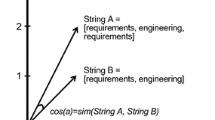Abstract
Requirements written in multiple languages can lead to error-proneness, inconsistency and incorrectness. In a Malaysian setting, software engineers are exposed to both Malay and English requirements. This can be a challenging task for them especially when capturing and analyzing requirements. Further, they face difficulties to model requirements using semi-formal or formal models. This paper introduces a new approach, Pair-Oriented Requirements Engineering (PORE) that uses an Essential Use Case (EUC) model to capture and analyze multi-lingual requirements. This approach is intended to assist practitioners in developing correct and consistent requirements as well as developing teamwork skills. Two quasi-experiment studies involving 80 participants in the first study and 38 participants in a subsequent study were conducted to evaluate the effectiveness of this approach with respect to correctness and time spent in capturing multi-lingual requirements. It was found that PORE improves accuracy and hence helps users perform better in developing high quality requirements models.
Access this chapter
Tax calculation will be finalised at checkout
Purchases are for personal use only
Preview
Unable to display preview. Download preview PDF.
Similar content being viewed by others
References
Kamalrudin, M., Grundy, J., Hosking, J.: Supporting requirements modelling in the Malay language using essential use cases. In: 2012 IEEE Symposium on Visual Languages and Human-Centric Computing (VL/HCC), pp. 153–156. IEEE (2012)
Regev, G., Wegmann, A.: Where do goals come from: The underlying principles of goal-oriented requirements engineering. In: Proceedings of the 13th IEEE International Conference on Requirements Engineering, pp. 353–362. IEEE (2005)
Goedicke, M., Herrmann, T.: A case for viewpoints and documents. In: Paech, B., Martell, C. (eds.) Monterey Workshop 2007. LNCS, vol. 5320, pp. 62–84. Springer, Heidelberg (2008)
Chen, Z., Ghose, A.: Web agents for requirements consistency management. In: Proceedings of the IEEE/WIC International Conference on Web Intelligence, WI 2003, pp. 710–713. IEEE (2003)
Albakry, K., Kamalrudin, M.: Pair analysis of requirements in software engineering education. In: 2011 5th Malaysian Conference in Software Engineering (MySEC), pp. 43–47. IEEE (2011)
Constantine, L.L., Lockwood, L.A.: Software for use: A practical guide to the models and methods of usage-centered design. Pearson Education (1999)
Biddle, R., Noble, J., Tempero, E.: Essential use cases and responsibility in object-oriented development. In: Australian Computer Science Communications, vol. 24(1), pp. 7–16. Australian Computer Society, Inc., Chicago (2002)
Constantine, L.L., Lockwood, L.A.: Structure and style in use cases for user interface design. Object Modeling and User Interface Design, 245–280 (2001)
Kamalrudin, M., Hosking, J., Grundy, J.: Improving requirements quality using essential use case interaction patterns. In: Proceedings of the 33rd International Conference on Software Engineering, pp. 531–540. ACM (2011)
Kamalrudin, M., Grundy, J.: Generating essential user interface prototypes to validate requirements. In: Proceedings of the 2011 26th IEEE/ACM International Conference on Automated Software Engineering, pp. 564–567. IEEE Computer Society (2011)
Kamalrudin, M., Grundy, J.: MaramaAI: Tool support for capturing requirement and checking the inconsistency. In: 21st Australian Software Engineering Conference. IEEE Computer society, Auckland (2010)
Bellini, E., Canfora, G., García, F., Piattini, M., Visaggio, C.A.: Pair designing as practice for enforcing and diffusing design knowledge. Journal of Software Maintenance and Evolution: Research and Practice 17(6), 401–423
Braught, G., Eby, L.M., Wahls, T.: The effects of pair-programming on individual programming skill. ACM SIGCSE Bulletin 40(1), 200–204 (2008)
Gehringer, E.F.: A pair-programming experiment in a non-programming course. In: Companion of the 18th Annual ACM SIGPLAN Conference on Object-Oriented Programming, Systems, Languages, and Applications, pp. 187–190. ACM (2003)
Sillitti, A., Succi, G., Vlasenko, J.: Understanding the impact of pair programming on developers attention: A case study on a large industrial experimentation. In: 2012 34th International Conference on Software Engineering (ICSE), pp. 1094–1101. IEEE (2012)
Canfora, G., Cimitile, A., Garcia, F., Piattini, M., Visaggio, C.A.: Evaluating performances of pair designing in industry. Journal of Systems and Software 80(8), 1317–1327 (2007)
Author information
Authors and Affiliations
Editor information
Editors and Affiliations
Rights and permissions
Copyright information
© 2014 Springer-Verlag Berlin Heidelberg
About this paper
Cite this paper
Kamalrudin, M., Sidek, S., Salleh, N., Hosking, J., Grundy, J. (2014). A Pair-Oriented Requirements Engineering Approach for Analysing Multi-lingual Requirements. In: Zowghi, D., Jin, Z. (eds) Requirements Engineering. Communications in Computer and Information Science, vol 432. Springer, Berlin, Heidelberg. https://doi.org/10.1007/978-3-662-43610-3_12
Download citation
DOI: https://doi.org/10.1007/978-3-662-43610-3_12
Publisher Name: Springer, Berlin, Heidelberg
Print ISBN: 978-3-662-43609-7
Online ISBN: 978-3-662-43610-3
eBook Packages: Computer ScienceComputer Science (R0)




